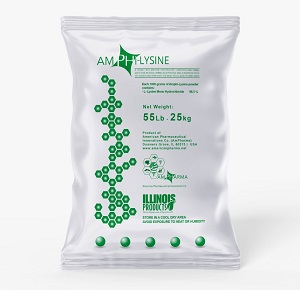AMPHILYSINE
Last Updated: Monday, January 30, 2023

Lysine feed additive for poultry, livestock and swine diets
For ideal amino acid profile and maximum feed efficiency and growth performance
For better meat yield, quality, and taste
Ingredients
L- Lysine Mono Hydrochloride 98.5 %
Product Description
- Lysine as a "limiting amino acid" for better feed efficiency, growth performance, and meat yield:
- In practical poultry diets, lysine is one of the first limiting amino acids. Therefore, supplementation of lysine to practical poultry diets provides a means for increasing the efficiency of protein utilization, and as a result N excretion will be reduced.
- During the last years more attention is paid to the ideal amino acid profile in poultry diets. In the ideal concept for poultry as well as for pigs' lysine is used as a standard, whereas the requirement for the other amino acids is expressed as a percentage of the need for lysine.
- The essential amino acid Lysine is often the limiting dietary amino acid in farm animals that consume predominantly cereal grain–based diets. Accordingly, most studies of the effects of dietary Lysine on farm animals have focused on feed efficiency, growth performance, and meat yield.
- Value of lysine in improving "meat quality and taste":
- Effect on "meat quality": Increasing dietary Lysine has been shown to increase final pH and decrease drip loss of broiler breast meat and reducing dietary Lysine has been shown to increase intramuscular fat in the longissimus dorsi muscles of finishing gilts.
- Effect on "meat taste" and free Glutamine muscle concentration: Various compounds contribute to meat flavor, including Glutamine, an important taste-active component in meat, therefore, appropriate concentrations of Glutamine increase food palatability. The addition of Glutamine to chicken soup increased its intensity of umami, sweetness, and saltiness; thus, an increase in the free Glutamine content of chicken improves its taste. However, dietary Glutamine is metabolized by intestinal cells during absorption, with only 5% of the Glutamine appearing in the portal blood. Therefore, it is difficult to increase the free-Glutamine content of muscle by the feeding of Glutamine-rich feeds; instead, an indirect method is required. The free-Glutamine concentration in chicken muscle can be increased by the feeding of a high- or low-Lysine diet. Also, Glutamine is the preferred fuel for respiration in chicken intestinal cells.
- In the feeding of a high-Lysine diet, the Lysine degradation pathway contributed to the free- Glutamine production.
Product Benefits
- AMPHILYSIN powder may be used in poultry, livestock and pigs' diet to improve efficiency of protein utilization, growth performance, and meat yield.
- AMPHILYSIN powder may be used in poultry, livestock and pigs' diet to improve meat quality by reducing intramuscular fat content.
- AMPHILYSIN powder may be used in poultry, livestock and pigs' diet to improve meat taste and palatability by increasing intramuscular free-glutamine content.

